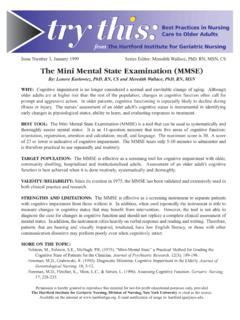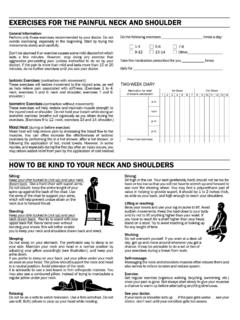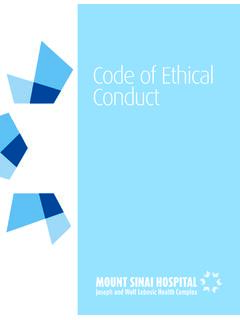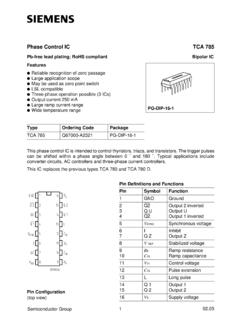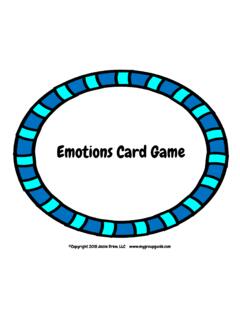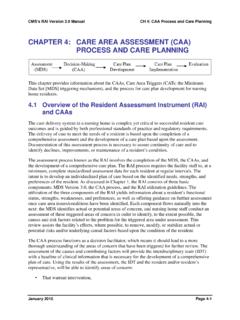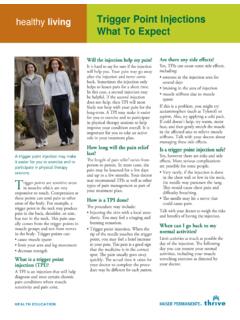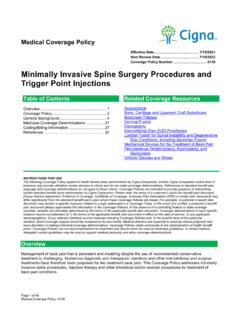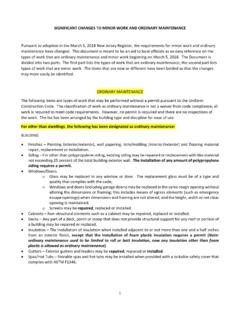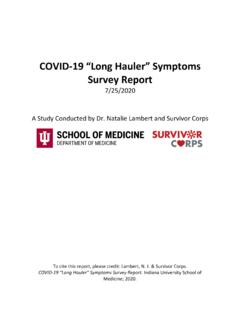Transcription of Living With Irritable Bowel Syndrome - Mount Sinai Hospital
1 Living with Irritable Bowel Syndrome Irritable Bowel Syndrome (IBS) is a condition affecting your digestive tract. There is no definite cause for IBS, but several factors may trigger IBS symptoms: low fibre diet high fat diet food intolerances increased use of antibiotics intestinal infections busy lifestyle/stress stomach surgery emotional upset combination of the above factors IBS symptoms can include: Bowel pain, changes in Bowel habits (diarrhea, constipation or both), bloating and gas, nausea, mucus in your stools, feeling of having an incomplete Bowel movement, or frequent urge to move your bowels. You may experience some or all of these symptoms but not necessarily at the same time. It is important to identify your own symptoms and the factors that trigger them. Diet, lifestyle changes and possibly medications may be needed to manage your symptoms. Management and Relief of IBS Symptoms 1. Remember that your Bowel is normal just Irritable .
2 2. Your Bowel will be at its best on a regular routine, such as eating meals at regular times throughout the day, and getting adequate sleep. 3. Identify and limit foods that trigger symptoms. 4. Eat plenty of fibre. 5. Identify sources of stress and strategies to manage them. 6. Practice relaxation strategies. 7. Enjoy regular physical activity. IBS is very individual and people have varying symptoms. Dietary management and treatment of IBS is based on an individual s specific symptoms. Therefore, self monitoring is important. This can include a journal to record food intake, symptoms, and stress. Page 1 of 7 The following information will help you manage your IBS symptoms through changes in your diet. If you have this symptom, .. try these diet adjustments Abdominal pain High fibre Low gassy foods Low caffeine Low fat Constipation High fibre, especially insoluble fibre Low caffeine High sugar-free fluid intake Diarrhea High fibre, especially soluble fibre Low caffeine Low fat and low spice Low sorbitol, sugars and sweets Decrease foods which may contribute to diarrhea: prune juice, coffee, beer, dried peas and beans High sugar-free fluid intake Gas Low gassy foods Low caffeine Bloating Low gassy foods Low fat Low caffeine Low sorbitol Other Diet Adjustments Alcohol this is a stimulant to your digestive system.
3 It causes the production of digestive juices and increases your appetite. For people with Irritable Bowel symptoms, it may also cause symptoms such as heartburn, abdominal pain, and diarrhea. If you drink alcohol, drink it in moderation (0 - 2 drinks a day for men; 0 - 1 drink a day for women; a drink is 5 oz of wine, 1 oz of liquor, or 12 oz of beer). If even a small amount triggers IBS symptoms, then it is best to avoid alcohol completely. Lactose this is sugar found in dairy products. Although lactose intolerance is a separate condition from IBS, it can produce similar symptoms gas, bloating, and diarrhea. It is important to determine if your symptoms are actually IBS, lactose intolerance or both. Your physician can perform specific testing to determine if you have a lactose intolerance. Another option is to eliminate lactose from your diet and see if the symptoms disappear. If you are lactose intolerant, removing lactose from your diet should help to decrease gas, bloating, and diarrhea.
4 Your dietitian can provide further direction if you wish to try a lactose-reduced diet. Page 2 of 7 Fibre Gradually increase your fibre intake from whole grain breads, cereals, fruits, vegetables, and legumes. Dietary fibre can be generally classified as soluble and insoluble. Both types are present in varying amounts in different plant foods, but some foods have more of one type than the other. Soluble fibre dissolves in water forming a gel in your stomach. This slows the rate of digestion. Good sources of soluble fibre include dried peas and beans, lentils, oats, barley, psyllium, apples and citrus fruits. Research is indicating that soluble fibre sources may be the most beneficial in treating IBS symptoms. Insoluble fibre does not dissolve in water but can hold a large amount of water. In this way, it acts to increase the bulkiness of stools and promote regular Bowel movements. Insoluble fibre food sources include wheat bran, whole grains and some vegetables.
5 You need 25 to 38 grams of total fibre per day. The following chart lists some high fibre foods. A food marked with an asterisk (*) is a good source of soluble fibre. Your dietitian can provide you with further detailed information on high fibre food sources if needed. Food 2 4 grams 4 6 grams More than 6 grams Breads (2 slices) bran muffin -1 small cornbread multigrain pumpernickel* rye* 100% whole wheat bran cracked wheat Mr. Pita, High Fibre - 1 pita Cereals (Portion size varies; check nutrition panel on package) All Bran Bran Flakes oat bran* Shredded Wheat Bran Chex Fruit and Fibre Raisin Bran Kashi Go Lean 100% Bran All Bran Original All Bran Buds * Fibre First Fibre One Grains (1/2 cup cooked) cornmeal natural bran - 1 tbsp wheat germ* whole wheat pasta psyllium* (1 tsp) brown rice bulgur barley* Vegetables and Legumes (1/2 cup cooked) asparagus, broccoli*, Brussels sprouts*, carrots, cauliflower, corn*, eggplant, green peas, spinach, squash* 1 baked potato with skin* 1 artichoke* black beans*, chick peas, kidney beans*, lentils*, northern beans*, pinto beans black-eyed peas*, navy beans Fruit 1 apple*, banana or orange* 3 apricots* cup raspberries* or rhubarb 1 cup strawberries* 1 pear* 1 cup blackberries* cup dried dates, prunes*, raisins Nuts and Seeds cup almonds, peanuts* (dry roasted) 2 tbsp flaxseed (ground)* Adapted from: Learning about.
6 Eating more fibre. Hamilton Health Sciences, 2006. Page 3 of 7 Note: it is very important to get adequate fluids as you slowly increase your fibre intake. Fibre needs water in order to work properly. Aim for 8 to 10 glasses of caffeine-free fluids daily--about half of this should be water. Gassy Foods Pay attention to how you are eating: Avoid gulping foods, eating quickly or talking while eating. This can increase gas production. Do not skip meals. Skipping meals allows your digestive system to fill with air. Avoid chewing gum or sucking on hard candy. Avoid using a straw to drink liquids. Choose fruits and vegetables that are generally well tolerated. When your symptoms are under control, add one food from foods which may cause discomfort to your diet. Try them cooked first and then fresh. If you do not have any symptoms from this food, include it in your diet once every three days. Then try including another food from this group.
7 By adding one food at a time to your diet, you will be able to identify foods that you can tolerate and limit those that cause IBS symptoms. Well-tolerated foods: cooked vegetables: o asparagus beets green/yellow beans carrots green peas o mushrooms potato sweet potato spinach squash o pumpkin zucchini vegetable juices fruits: o canned fruit peeled apples soft, ripe banana grapefruit kiwi o nectarine orange peach pear Foods which may cause discomfort (this will vary from person to person): raw vegetables the following vegetables even if cooked o broccoli cauliflower Brussels sprouts cucumber cabbage o corn kohlrabi rutabaga leeks sauerkraut o onion scallions red/green pepper shallots pimentos o turnip radish dried peas, beans, and lentils, such as.
8 O kidney beans, lima beans, navy beans, split peas, lentils, black-eyed peas some fruits - unpeeled apples, avocados, cantaloupe, melon, prunes, watermelon other foods - beer, hard-boiled eggs, nuts, popcorn, seeds, soft drinks, wheat germ Page 4 of 7 Caffeine Caffeine can be a stomach irritant. Aim for less than 400 mg caffeine per day. If symptoms continue to occur, you may need to decrease caffeine further. Common caffeine sources: mg mgCoffee (6 oz) filter drip 110 180 Chocolate milk (225 mL) 2 7 instant 60 90 Dark chocolate bar (2 oz) 40 50 Milk chocolate bar (2 oz) 3 20 Tea (6 oz) weak 20 45 strong 79 110 Cold remedies (1 tablet) 15 30 Cola drinks (280 mL can) 22 50 Headache remedies (1 tablet) 30 32 Fatty Foods High fat foods slow stomach emptying and movement of food through the Bowel . They can cause bloating and sometimes diarrhea.
9 You will not likely need to reduce your fat intake below the current recommendations for all Canadians, which is less than 30% of calories from fat (at 1800 calories, this is 60 grams of fat, at 2500 calories, this is 80 grams of fat). Although your Bowel doesn t recognize the difference between the types of fat ( saturated vs unsaturated), your heart and blood vessels do so the low fat diet should be low in saturated types of fat from high fat meats and dairy products and hydrogenated fats, and use small amounts of unsaturated fats from fatty fish, nuts, canola oil, extra virgin olive oil, and non-hydrogenated margarine. Some tips: 1. Go lightly on added fats: a. Choose light non-hydrogenated margarines. b. Use jam or jelly instead of a fat spread. c. Choose low-fat mayonnaise, sour cream, and salad dressings. 2. Choose lower fat dairy products: a. Drink skim or 1% milk. b. Choose fat-reduced yogurt (less than 1% milk fat [ ]. c.)
10 Choose fat-reduced cheese (less than 20% ) d. Choose frozen yogurt, low-fat ice cream, or frozen ice milk. 3. Choose lean meats and use low-fat cooking methods: a. Lean cuts of beef round, sirloin, blade, extra lean ground, filet, stew meat b. Lean cuts of chicken skinless chicken breasts; remove skin and fat from other cuts. c. Lean cuts of pork tenderloin; loin chips; and ham with fat removed d. Lean sandwich fillings sliced beef, chicken, ham, pastrami, turkey e. Lean cooking methods barbecuing, baking, broiling, roasting, stewing, steaming, braising. Page 5 of 7 4. Watch out for hidden fats: a. Make reduced-fat muffins, cookies, pancakes, and waffles rather than buying their higher-fat versions from the baker or grocery store. b. Monitor the fat in baked goods. Check labels. c. Choose crackers/snack foods with less than 3 grams of fat per serving, and avoid those with hydrogenated oils. Fructose Fructose is a sugar found in fruit, some root vegetables and honey.
